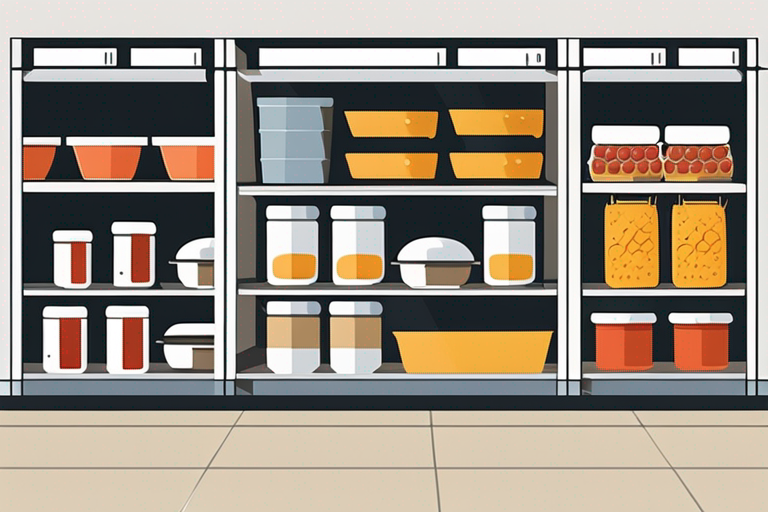
How Long Can You Keep Food: A Guide to Food Storage and Safety
Get Your Free Food Safety Cheat Sheet
30 most common foods with instant answers. Print it and stick it on your fridge—completely free!
How Long Can You Keep Food: A Guide to Food Storage and Safety
In today's fast-paced world, it's essential to know how long you can keep food to ensure its safety and quality. Proper food storage not only prevents foodborne illnesses but also helps in reducing food waste. In this comprehensive guide, we will explore the recommended storage times for various types of food and provide you with practical tips to extend the shelf life of your groceries.
Understanding Food Shelf Life
Before we delve into specific food items, it's crucial to understand the concept of food shelf life. The shelf life of a food product refers to the length of time it can be stored under proper conditions while maintaining its quality and safety. Factors such as temperature, humidity, packaging, and storage methods can all influence the shelf life of food items.
Factors Affecting Food Shelf Life
Several factors can affect the shelf life of food products. Here are some of the most common ones:
-
Temperature: Temperature plays a significant role in food spoilage. Refrigeration can help extend the shelf life of perishable items, while freezing can preserve food for even longer periods.
-
Packaging: Proper packaging can protect food from air, moisture, and light, all of which can accelerate spoilage.
-
Storage Conditions: Storing food in a cool, dry place away from direct sunlight can help maintain its quality and safety.
-
Type of Food: Different types of food have varying shelf lives. Perishable items like dairy and meats have shorter shelf lives compared to pantry staples like rice and pasta.
Recommended Storage Times for Common Food Items
Now, let's explore the recommended storage times for some common food items:
Fruits and Vegetables
- Berries: Store in the refrigerator and consume within 3-5 days.
- Leafy Greens: Wrap in a paper towel and store in a breathable bag in the refrigerator for 3-5 days.
- Citrus Fruits: Store at room temperature for up to a week or in the refrigerator for longer shelf life.
Dairy Products
- Milk: Consume within a week of the sell-by date.
- Cheese: Hard cheeses like cheddar can last up to 6 months in the refrigerator, while soft cheeses like brie should be consumed within 1-2 weeks.
- Yogurt: Consume by the expiration date on the package for the best quality.
Meat and Seafood
- Chicken: Cook or freeze within 1-2 days of purchase.
- Beef: Store in the refrigerator for 3-5 days or freeze for longer storage.
- Fish: Consume fresh fish within 1-2 days or freeze for up to 3 months.
Pantry Staples
- Flour: Store in an airtight container in a cool, dark place for up to 6 months.
- Canned Goods: Consume within 1-2 years for the best quality.
- Rice and Pasta: Store in airtight containers in a cool, dry place for up to 2 years.
Tips for Extending Food Shelf Life
To make the most of your groceries and reduce food waste, consider the following tips for extending the shelf life of food items:
- **Properly label and date items in your pantry and refrigerator to track their freshness.
- **Rotate older items to the front of your pantry or refrigerator to ensure they are used first.
- **Invest in quality storage containers and bags to keep food fresh longer.
- **Regularly clean and organize your pantry and refrigerator to prevent forgotten items from spoiling.
By following these simple tips, you can maximize the shelf life of your groceries and enjoy fresh, safe food for longer periods.
Conclusion
Knowing how long you can keep food is essential for maintaining food safety and quality. By understanding the recommended storage times for various food items and implementing practical tips for extending shelf life, you can minimize food waste and enjoy fresh, nutritious meals. Remember to always follow proper food storage guidelines and pay attention to expiration dates to ensure the safety of your food. With these guidelines in mind, you can make the most of your groceries and create delicious meals with confidence.

Authoritative Food Safety References
These agencies and university labs inform every tip and health precaution we publish.
USDA FoodKeeper – Cold Storage Guidelines
Official refrigerator, freezer, and pantry timelines maintained by the U.S. Department of Agriculture.
Visit USDA FoodKeeperFDA Produce Safety Rule & Grower Guidance
Field-to-fridge handling practices that prevent contamination of fruits, vegetables, and leafy greens.
Visit FDA Produce SafetyCDC Foodborne Illness Prevention Hub
Surveillance-backed guidance on pathogens, symptoms, and steps to reduce foodborne illness risk.
Visit CDC Food SafetyUC Davis Postharvest Technology Center
University research detailing optimal storage atmospheres for produce after harvest.
Visit UC Davis PostharvestPenn State Extension – Home Food Preservation & Safety
Peer-reviewed extension bulletins on safe canning, chilling, and reheating practices.
Visit Penn State ExtensionHow long can you keep cooked chicken in the refrigerator?
What is the best way to store fruits and vegetables to prolong their shelf life?
How long can you keep leftovers in the freezer?
Can you reheat leftovers more than once?
How can I tell if food has gone bad?
Get Your Free Food Safety Cheat Sheet
30 most common foods with instant answers. Print it and stick it on your fridge—completely free! Want more? Upgrade to the complete guide with 70+ foods.
Scan your food directly and get instant safety info using our AI-powered camera feature.